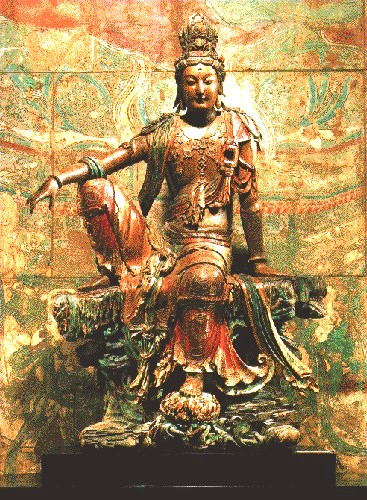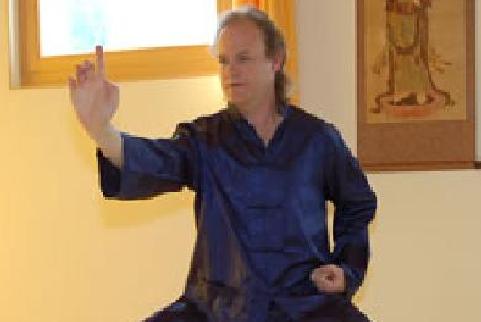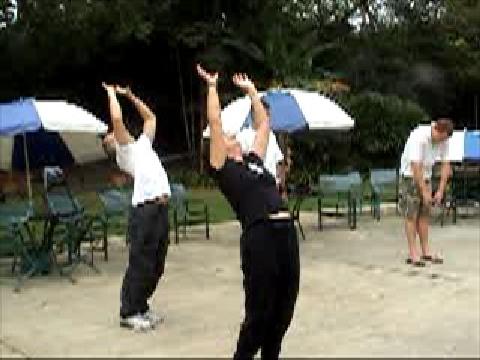November 2007 (Part 2)
SELECTION OF QUESTIONS AND ANSWERS

Guan Yin, the Bodhisattva of Great Compassion. This picture is reproduced from http://www2.kenyon.edu/Depts/Religion/Fac/Adler/Reln260/bodhisat3.htm
Question 1
During a vacation I had an unusual experience. In a 300 hundred year old hotel I felt a number of spirits. In particular, I saw a young girl's spirit who had been very sick in her bed and screaming for help. I saw no one was helping her, though a number of other spirits swarmed around me.
— Andre, Canada
Answer
Ghosts as well as gods are all around us, but humans normally do not see them because they exist in energy that is too fine for our human eyes to perceive. When we practice high-level chi kung, we enhance our perception and may be able to see them.
My sifu, Sifu Ho Fatt Nam who was a very high-level spiritual master, used to remind us that “koi tau sam jeak yow shen ming”, which means “there are gods all around you just three feet above your head”. This is a warning that any person who thinks he can commit evil secretly without anyone knowing is grossly mistaken.
Old cities are full of spirits. When I was in that same city some time ago, I could feel their presence, but they did not affect me at all.
Question 2
I felt disturbed by the experience. I besought Bodhisattva Guan Yin to help free the spirits as I felt they were trapped in the hotel. I also besought Bodhisattva Guan Yin to protect the people in the hotel from the spirits. I had a vision that this old hotel used to be some type of a brothel.
The following day a restaurant owner told me that the 300 hundred year old hotel had been haunted by ghosts. A Casanova type of person used to live in that hotel many many years ago and spirits haunted the hotel. That evening, Bodhisattva Guan Yin took me to a beautiful place in the Cosmos and showed me how the spirits were happy and now free from the hotel.
I felt relieved that the spirits were now free but I also felt that this Casanova spirit was not happy that the other spirits were freed. However, I felt that Bodhisattva Guan Yin and Grandmaster Lam Sai Weng would protect me. I also asked them for protection.
Answer
What you did was correct, and I am proud of you. It was so wonderful that Bodhisattva Guan Yin set the spirits free as well as took you to a beautiful place in the Cosmos. It was a rare privilege. Congratulations.
Lower spirits could not harm you at all. Not only you are protected by Bodhisattva Guan Yin and Grandmaster Lam Sai Weng, your own energy field acts like a shield of electricity to lower spirits. Any spirit that comes close will be bounced away by your good energy.
My chi field is so powerful that spirits would move away when I approach. Years ago when I had to drive along a road besides a cemetry on the way to teach chi kung in Bukit Mertajam in Malaysia, I used to send a message to the spirits there not to be worried as I had no intention to harm them.
On another occasion, a student took a picture of me as I entered a room. When the film was developed, the photograph showed a partial limb of a monster-spirit (which is much more powerful than a ghost) moving away at the door. None of the people present felt anything unsusal at the time. It is a pity I could not find that photograph now.
Question 3
Is there a way a person can protect oneself from seeing these spirits? Also is there a way to protect oneself from spirits harming him? I know these questions may seem rather odd.
Answer
You can protect yourself by chanting a powerful mantra, like “Namo Guan Shi Yin Bodh Satt” or “Om, mani padme Om”.
Our “One-Finger Zen” is a powerful weapon against spirits. If you shoot chi at them, you could harm them. So, don't do it. It is sufficient if you show them the “One-Finger Zen”, with the index finger pointing upward.

The “One-Finger Zen” hand-form demonstrated by Sifu Andrew Barnett
Question 4
I also have seen a number of visions of both the past and the future. I have been able to verify that my visions of the past did occur. I am wondering if such visions are normal during the progression of one's chi kung. Is it a normal part of the growth of one's energy level or is it some sort of a deviation?
Answer
Seeing visions of the past and the future is one of the less common results of practicing high-level chi kung. It is regarded as “shen tong” or “miraculous ability”. Congratulations for this high-level achievement.
Although I know you will not abuse this rare ability, it is my duty to remind you that not only you must always use it only for good, but also you must not reveal what is called “heaven's secrets” indiscriminatingly.
Often, especially in the beginning, it may not be easy for you to tell whether you could reveal a vision, especially when you think it could be beneficial to the person involved. For example, you see in a vision that a friend is to be killed in an accident.
Should you tell him? Often you should not. You may give subtle hints, and you can pray for him. At the cosmic level, you might be doing him a disservice by warning or even helping him to avoid his death! At our human level, death is totally unwelcome, to be avoided at all cost. But at the cosmic level, death is just a transition; it may lead to a happoer life for the person involved. In case of doubt, ask God, and you will always be given an answer, though the answer may not come explicitly.
Question 5
Sometimes after stance training I can see people's energy. My two year old nephew seems to have a very strange energy pattern whereby his energy coming from the top of his head is spiraling out like a cone with the point on top. I have noticed he loves to run around in the same direction as the energy pattern which is counterclockwise. Does that particular energy pattern mean anything? Is anything wrong with him if he has that type of energy pattern?
Answer
Seeing other people's energy, though not common, is less uncommon in our chi kung development. Many of our Shaolin Wahnam Family members have this ability. They also told me that the energy pattern not only confirmed but preceeded the physical movement. For example, if a person intends to move forward, his energy is extended forward first.
The energy pattern is determined by thought. In other words, first he thinks of moving forward. Then his energy extends forward. This is followed by his physical movement forward. This is the reason why some of us know the movements of our partners in sparring or our opponents in fighting. We pick up their thoughts or sense their energy before their physical movements.
There was nothing wrong with the energy pattern of your nephew. It indicated his state of mind, including his thoughts and emotions.
Question 6
Is it normal to sweat when you do Chi Kung? I have been practicing “Lifting the Sky” and I sweat every time even though I stay relaxed. Is this normal?
— Cesar, USA
Answer
Yes, it is normal to sweat when practicing chi kung. Sweating is one of Nature's way to clear toxic waste from your body. For those who don't sweat, it is advisable to have some warm drink before the practice to induce sweating. After the practice it is advisable to have a warm drink to replenish liquid lost.

Participants at an Intensive Chi Kung Course performing “Carrying the Moon”
Question 7
I have a C3-C4 slipped disc. Which qigong exercises will be helpful for me?
— Simuti, India
Answer
Although conventional Western medicine finds it difficult to fix a slipped disc, it is relatively easy to fix in chi kung. It may be incrediable to many people and sound like a big lie to sceptics, but it is true that many people have had their slipped discs fixed within a short time after learning from us, some in just one session!
Western doctors are hesitant to handle slipped discs because they are worried that it may affect the spinal cord of the patients. Hence they ask their patients not to bend their back. Their routine treatment is to prescribe pain killers which null the pain, but the problem remains.
The spinal cord is well protected by the vetebrae which are actually separate but firmly held together by tendons. In the case of a slipped disc, the disk is slightly displaced, but it is not to the extent where the bones are threatening the spinal cord. If it were, the person would experience severe pain, and he would have to be in bed. The fact that he could still move about and perform chi kung exercise is a good indication that his spincal cord is still well protected.
When an energy flow is generated by an appropriate chi kung exercise, the energy massages the muscles and tendons around the slipped disc, and causes the patient to move in such a way, usually in a forward-backward bending movement, that the vertebrae open and close.with the result that the slipped disc is pushed back in place. It is actually that simple. The movement can sometimes be quite vigorous, and may cause some concern to the inintiated, but it is always safe because this chi flow will always work to the best interest of the person.
An excellent exercise is “Carrying the Moon”. But you need to perform it as a chi kung exercise and not as a gentle physical exercise. The main difference is that gentle physcial exercise works on the physical body whereas chi kung works on energy. If you practice on your own form books or video or learn from a mediocre teacher, it is almost certain you will practice it as a gentle physical exercise, which will not be able to overcome your slipped disc problem. You have to learn chi kung from a genuine master.
Question 8
In my last lesson, I was given an assignment to figure out for each movement in the long Yang form, whether the palms are yin or yang and why. For example, in Single Whip the left palm is yin, whilst the right palm is yang. What makes a palm yin or yang?
— Joe, Isreal
Answer
Yin and yang are symbols. This means they have different meanings in different context. What is yin in one context can be yang in another.
By convention, yin refers to what is feminine, negative, dark, retreating, substantial, and the like, whereas yang refers to their counterparts. What many people often forget is that whether an object or event is negative, feminine, etc is relative and not absolute. In other words, we refer to an object as yin in relation to another object which we refer to as yang. This yang object is usually not mentioned, but undestood. Without the other object for comparision, we cannot rightly say the first object is yin or yang.
For example, when we refer to a woman as yin, we compare her to a man whom we refer to as yang. This man may not be mentioned, but it is understood. Without the man for comparison, we cannot rightly refer to the woman as yin or yang.
If, instead of comparing the woman with the man, we compare her with a girl who is smaller and weaker than her, then the woman is yang and the girl yin.
Now let us take the young girl as an example. We are not going to compare her with another person, but compare two aspects of her. One aspect is her form, or substance, and the other aspect is her function. By convention, her substance is referred to as yin, and her function as yang. Because she is young, asking her to produce children would be disharmonious of yin and yang, but asking her to be a good student in school would be harmonious of her substance and her function.
With this background understanding of yin and yang, it is not difficult to see that merely referring to the palms of each movement in a Yang Style Taijiquan set as yin or yang without any point of reference, is irrelevant. Each palm can be yin or yang depending on what point of reference we use.
If our point of reference is the shape of the palms, then in the Single Whip pattern where the left palm is open in a strike, and the right palm is held in a hook, the left palm is yang and the right is yin. This is because be convention, what is open is referred to as yang, and what is close or partially close as in a hook is yin.
If our point of reference is the function of the palms, the left palm is still yang and right palm yin. This is because an attack is conventionally referred to as yang, and a defence as yin. In this case the left palm is an attack movement as it is meant to strike an opponent, whereas the right palm is a defence movement as it is meant to hook away or grip an opponent's attack.
It is worthwhile to know that when past masters used yin-yang to describe objects and events, they did so for practical benefits and not for intellectual pleasures. Hence, if we wish to describe one palm of a Taijiquan technique as yin and the other yang, this should be justified by the benefits we get from the description. Otherwise, it is not only a waste of time and effort, but may cause unnecessary confusion by reading meanings into the forms when the meanings are actually not there. Unfortunately, some teachers tend to do this, perhaps mistakenly thinking that this could make their teaching appear profound.
A good way to assess whether it is necessary to designate yin-ynag to any object or event is as follows. Taking the Single Whip technique as an example, we can ask whether it makes any difference to refer to one palm yin or yang, or whether the yin-yang designation is needed at all. If it makes no difference, or worse, if the difference is negative, i.e. it makes the understanding and application of the technique more difficult or complicated, then logically it is better to forget about yin-yang despite its tempting intellectualization.
In the example I gave, it is useful to refer to the left palm as yang and the right palm as yin because it enables us to better understand and apply the technique as a strike. The right hook hand enables a better flow of internal force to the left open palm. If the right palm were open too, the energy would be disipated instead of focussed at the left palm.
In this case I am justified to use the yin-yang designation because I understand the nature of internal force involved. But if someone who does not understand, uses the yin-yang designation because he thinks it makes him sound profound, he is unjustified.
It is also significant to note that as in Eastern tradition, my designation of yin-yang in the Single Whip technique came after my understanding and experience of its energy flow, and not before it. In other words, I experienced the nature of energy flow first, then I explained what happened using the yin-yang philosophy. It is not that I intellectualized on yin-yang philosophy first, then thought of ways to put this philosophy into action.
The “philosophy first, experience later” approach, which is common in Western societies, may be detrimental. For example, someone may have read about the yin-yang philosophy, then he attempts to force this concept into the Single Whip technique. He intellectualizes that as the striking palm is yang and is open, the other palm is yin, and should be closed in a fist. This will not only reduce the internal force in the palm strike, but will cause energy blockage in the arms and body.
LINKS
Selected Reading
- Traveling Dragon and Ferocious Tiger
- The Profundity of the Twelve Tantui Combat Sequences
- Sharing Secrets for Combat Efficiency
- The Difference between Regional and Intensive Courses
- The Reality of Chi and Internal Force
